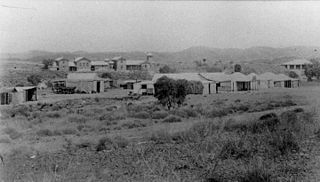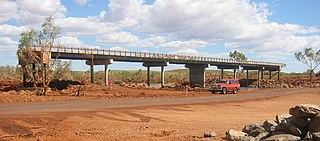Related Research Articles
The Pilbara is a large, dry, thinly populated region in the north of Western Australia. It is known for its Aboriginal peoples; its ancient landscapes; the red earth; and its vast mineral deposits, in particular iron ore. It is also a global biodiversity hotspot for subterranean fauna.

Marble Bar is a town and rock formation in the Pilbara region of north-western Western Australia. Its extremely hot climate, with a mean maximum temperature second only to Wyndham, Western Australia has resulted in the town being well known for its hot weather.

The Port Hedland–Marble Bar railway was a railway in the Pilbara region of Western Australia, running into the hinterland from the north-west coast.
The De Grey River is a river located in the Pilbara region of Western Australia. It was named on 16 August 1861 by the explorer and surveyor Francis Gregory after Thomas de Grey, 2nd Earl de Grey, who was at the time the president of the Royal Geographical Society.

The Fortescue River is an ephemeral river in the Pilbara region of Western Australia. It is the third longest river in the state.

Robe River is a river in the Pilbara region of Western Australia.

The Maitland River is a river in the Pilbara region of Western Australia.
The Nullagine River is a river in the Pilbara region of Western Australia.

The Oakover River is a river in the Pilbara region of Western Australia.
The Henry River is a river in the Pilbara region of Western Australia.
The Yule River is an ephemeral river in the Pilbara region of Western Australia. It was named on 10 August 1861 by the surveyor and explorer Frank Gregory while on expedition in the area, after Thomas Newte Yule, at times farmer of Toodyay, winemaker, Acting Colonial Secretary and Magistrate.
The Cane River is a river in the Pilbara region of Western Australia.
The Shaw River is an ephemeral river in the Pilbara region of Western Australia. It was named by explorer F.T. Gregory on 21 August 1861 after Norton Shaw, Secretary of the Royal Geographical Society.
The Rudall River is an ephemeral river in the Pilbara region of Western Australia. The entire length of the river is located within the boundaries of the Karlamilyi National Park, which straddles the Little Sandy Desert (LSD) and the Great Sandy Desert (GSD).
The Angelo River is a river in the Pilbara region of Western Australia.
Balla Balla River is a river in the Pilbara region of Western Australia.
The George River is a river in the Pilbara region of Western Australia. The river was named on 16 July 1861 by the surveyor and explorer Frank Gregory, who was conducting an expedition in the area. It is not known after whom he named the river.
Main Roads Western Australia controls the major roads in the state's Pilbara region. There are two main highways in the region: Great Northern Highway, which travels north through the region to Port Hedland and then north-west along the coast, as well as North West Coastal Highway, which heads south-west from Port Hedland. A series of main roads connects towns to the highways, and local roads provide additional links. The majority of these roads service the western half of the region, with few located in the various deserts east of the Oakover River. Roads are often named after the towns or areas they connect.
Coongan Station is a pastoral lease that was once a sheep station but now operates as a cattle station in Western Australia.
Corunna Downs Station is a pastoral lease that was once a sheep station but now operates as a cattle station in Western Australia.
References
- ↑ "Bonzle Digital Atlas – Map of Coongan River". 2009. Retrieved 19 April 2009.
- ↑ "History of river names – C". Western Australian Land Information Authority. Retrieved 3 September 2011.
- ↑ "Surface Hydrology of the Pilbara Region Summary" (PDF). 2000. Archived from the original (PDF) on 29 June 2009. Retrieved 17 April 2009.
- ↑ "Ausanthrop - Australian Aboriginal tribal database". 2009. Retrieved 19 April 2009.
Coordinates: 20°34′52″S119°35′30″E / 20.58111°S 119.59167°E